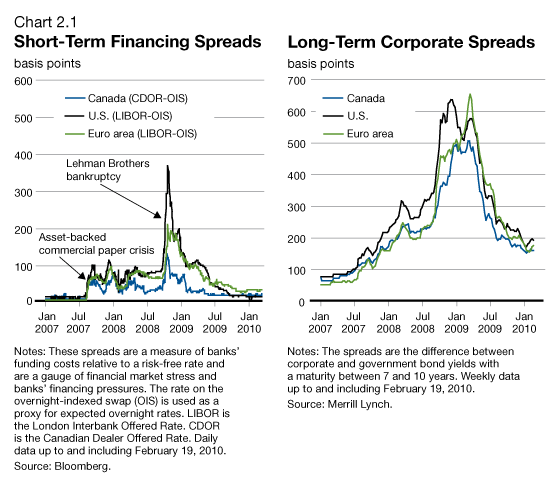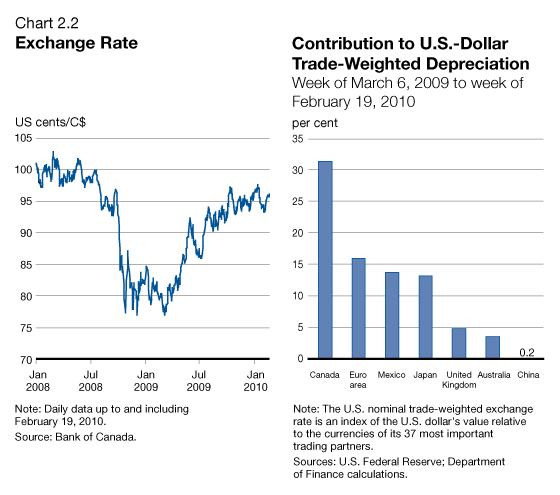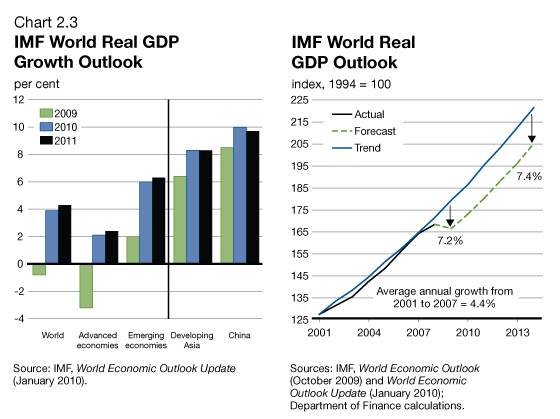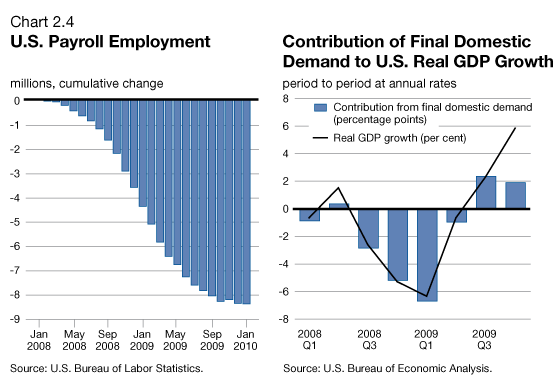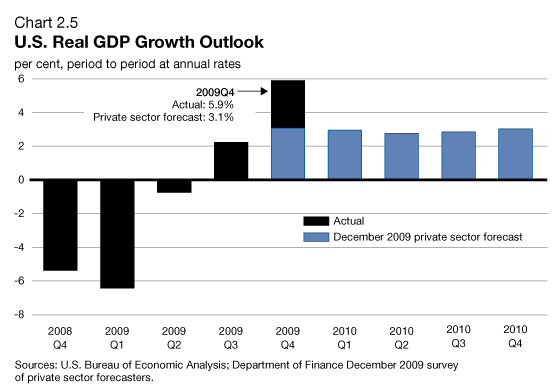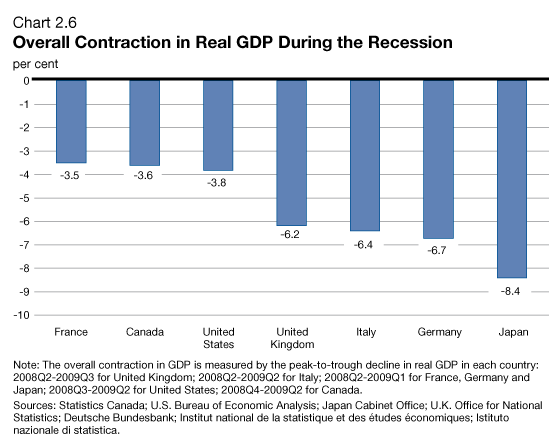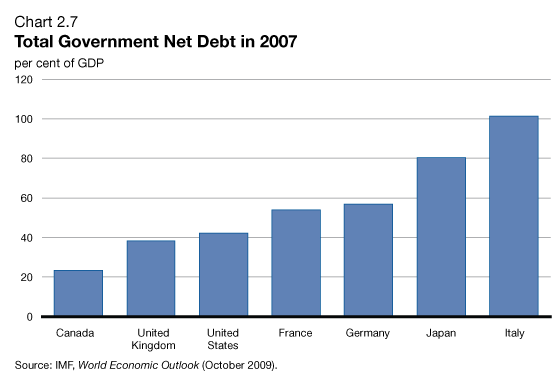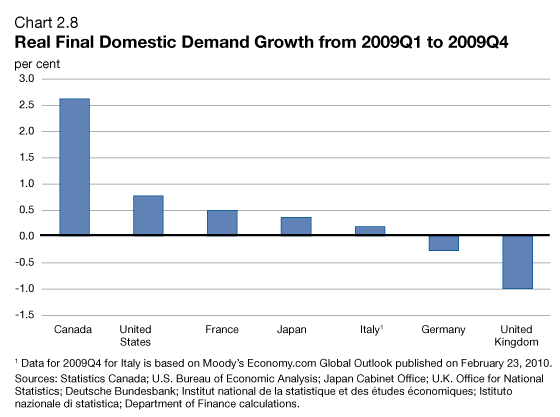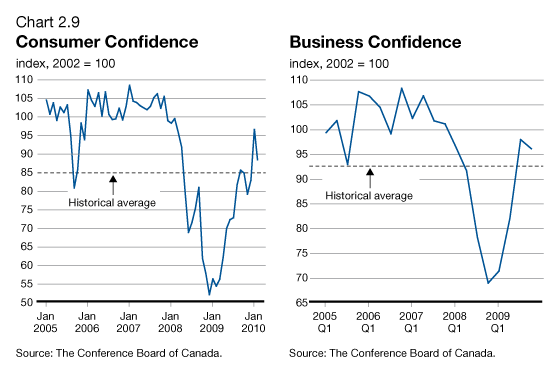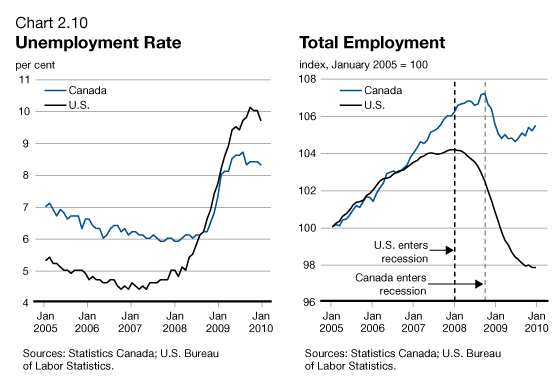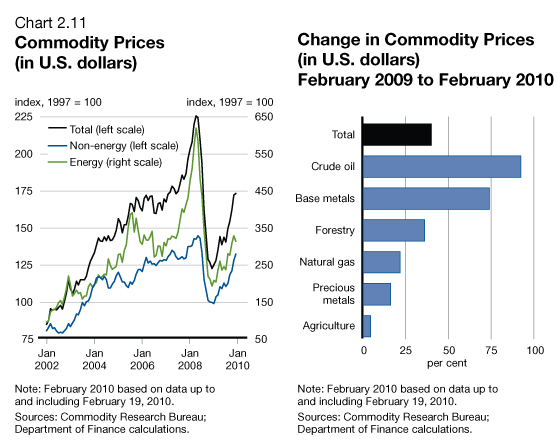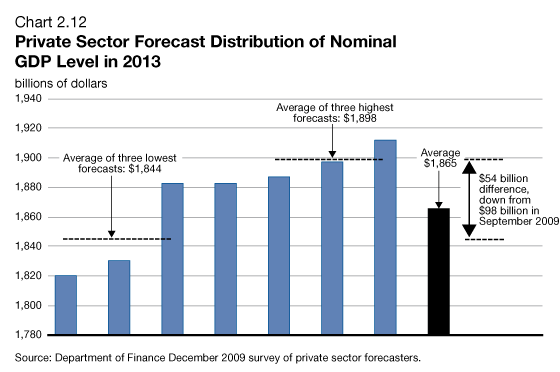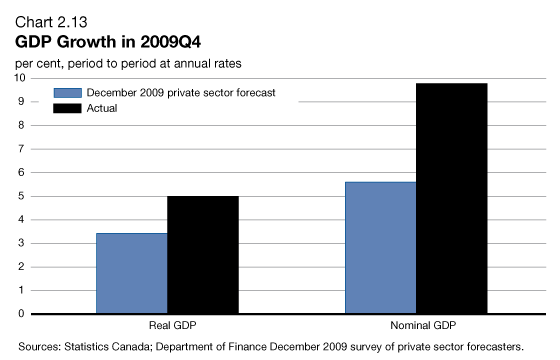Common menu bar links
archived - Chapter 2: Recent Economic Developments and Prospects
Table of Contents - Previous - Next
Highlights
- The global economy has begun to stabilize after undergoing a deep and synchronized recession, which stemmed from the worst global financial crisis since the 1930s.
- With support from the extraordinary measures in Canada's Economic Action Plan, the Canadian economy has started to recover.
- Canada has weathered the global recession better than all other major industrialized countries, reflecting several important financial, economic and fiscal strengths.
- Canadian labour markets have fared much better than in the U.S., where job losses to date have been proportionately more than three times as large as in Canada.
- Domestic demand in Canada has also rebounded more strongly than in all other Group of Seven (G7) countries since the beginning of 2009.
- While unemployment remains a concern, the rise in the unemployment rate has been smaller than was initially forecast by private sector forecasters.
- The Department of Finance conducted a survey of private sector forecasters in December 2009. In early February, private sector forecasters met with the Minister of Finance to discuss the economic forecast from the survey as well as the risks associated with that forecast.
- The average private sector economic forecast from the December 2009 survey forms the basis of the Government's fiscal planning.
- The use of private sector forecasts introduces an element of independence into the Government's economic and fiscal forecast.
- Over the short term, the average private sector economic forecast has improved somewhat since the September 2009 Update of Economic and Fiscal Projections. Private sector forecasters expect the Canadian economic recovery to build momentum through 2010.
- Private sector forecasters have not materially changed their medium-term outlook since the September Update. Over the medium term, the level of uncertainty surrounding the outlook has declined since the Update but remains high.
- The average private sector forecast from the December survey provides a prudent basis for fiscal planning.
Introduction
The global economy has begun to stabilize after undergoing a deep and synchronized recession, which stemmed from the worst global financial crisis since the 1930s. Since then, global financial markets have improved and confidence is returning, leading to a tentative resumption of global economic growth.
Reflecting these positive developments, together with the impact of Canada's Economic Action Plan and significant monetary policy stimulus, economic activity in Canada has also strengthened. The near-term outlook has improved since the Government's September 2009 Update of Economic and Fiscal Projections. Both gross domestic product (GDP) and employment have increased, and private sector economists continue to believe that the recovery will gain momentum through 2010. However, the economic recovery is expected to be modest, and uncertainty surrounding the economic outlook remains elevated.
This chapter reviews the major global and Canadian economic developments since the September 2009 Update, describes the private sector economic forecast that forms the basis for the fiscal projections, and discusses the risks and uncertainties surrounding this economic outlook.
Financial Market Developments
The global financial crisis of late 2008 and early 2009 resulted in a pronounced tightening in credit conditions worldwide, which had significant impacts on global economic activity. Global financial conditions have improved considerably since early 2009 due to the extraordinary policy measures introduced by governments and central banks to support the financial system worldwide. Wholesale borrowing costs of banks have declined, and spreads between corporate and government bond rates have narrowed considerably (Chart 2.1). World equity markets have also rebounded strongly over the past year, with most major benchmark indices rising between 50 per cent and 65 per cent since March 2009.
While global financial conditions have improved markedly over the past year, they have yet to fully normalize. In some markets, credit conditions remain relatively tight in terms of both the availability and price of credit, particularly at longer maturities.
In Canada, financial conditions were less affected by the global financial crisis than in most other countries. Wholesale bank borrowing costs rose much less in Canada and improved faster than in other countries, while corporate bond rate spreads remain below those of the U.S. and Europe. As a result, credit growth in Canada has remained solid, mainly due to continued strong household credit growth. Business credit growth is showing some signs of stabilization after decelerating in late 2008 and most of 2009 due to the impact of the recession on both the demand for and supply of credit. A continued recovery in bond and equity market financing shows that businesses have greater access to capital.
The U.S. dollar has depreciated by about 10 per cent on a trade-weighted basis since March 2009 against a broad group of currencies. This, together with higher commodity prices, has contributed to an appreciation of about 20 cents in the Canadian dollar relative to the U.S. dollar since the beginning of March 2009, peaking at US97.5 cents on January 14, 2010 (Chart 2.2). The Canadian dollar has accounted for a large share of the broad depreciation of the U.S. dollar.
Global Economic Developments and Outlook
The global economy began to expand in the second half of 2009, supported by extraordinary policy stimulus. The policy-induced recovery, in turn, has led to a recovery in global trade and an end to the inventory liquidation cycle. Nonetheless, the recovery in most advanced economies is expected to be weak by historical standards.
The recovery remains fragile in advanced economies. Most of the advanced economies emerged from recession in the third quarter of 2009, although the recovery in some countries appears to have stalled in the fourth quarter, primarily within the euro area. Most major industrialized economies are experiencing weaker domestic demand growth than overall GDP growth. In these countries, the economic recovery is led by export growth and an end to the cycle of inventory liquidation. Canada is unique in that the economic recovery is being led by strong domestic demand growth.
After having previously contracted for five consecutive quarters, real GDP in the euro area recorded a second consecutive modest increase in the fourth quarter of 2009 (0.4 per cent). However, growth in a number of member countries, including Germany and Italy, was flat or negative in the fourth quarter. Real GDP grew 1.1 per cent in the United Kingdom in the fourth quarter of 2009 after having contracted for six quarters. After a year-long recession, real GDP in Japan has expanded in two of the last three quarters, including a 4.6-per-cent increase in the fourth quarter.
The economic recovery is strongest in emerging and developing countries, led by Asian economies, particularly China, where massive fiscal stimulus has buoyed domestic demand. This in turn has supported a recovery in global trade. Despite the severe global downturn and the disruption of trade, the Chinese economy grew 8.7 per cent in 2009, including a 10.7-per-cent year-over-year increase in the fourth quarter of 2009, the fastest pace in two years.
Looking forward, the forces currently driving the recovery in advanced economies are expected to gradually weaken, as positive contributions to growth from inventories diminish and as the impact of fiscal stimulus fades toward the end of 2010 and early 2011. A sustained recovery will require increased support from private sector spending. The International Monetary Fund (IMF) expects global economic activity to grow by 3.9 per cent in 2010 and 4.3 per cent in 2011, led by developing Asian countries and China (Chart 2.3).
The expected rebound is relatively modest compared to previous recoveries, especially given the sharp drop in output last year. Based on the IMF outlook, the output lost during the recession is not expected to be recouped over the medium term. The IMF outlook suggests that the level of global GDP will be about 7.5 per cent lower in 2014 than it would have been if pre-recession trends had continued. This loss reflects the view that the level of activity prior to the crisis was unsustainably high, as it was based on excessive risk taking, an unsustainably low cost of financing, and rising leverage.
United States
Economic growth in the United States has resumed. This follows a peak-to-trough decline in real GDP of 3.8 per cent, which has resulted in a record loss of 8.4 million jobs (or 6.1 per cent of U.S. jobs) and left the unemployment rate at 9.7 per cent, near a 26‑year high (Chart 2.4). Real GDP rose 2.2 per cent in the third quarter of 2009 and accelerated to a six-year high of 5.9 per cent in the fourth quarter. Final domestic demand in the U.S. remains weak, growing by only 1.6 per cent in the fourth quarter and accounting for less than a third of overall growth in the quarter.
The depreciation of the U.S. dollar since March 2009 and the continued improvement in global growth have supported the U.S. trade sector. In the fourth quarter of 2009, these developments were accompanied by a substantial rebound in inventory investment from very low levels, resulting in significantly stronger U.S. growth than was anticipated by private sector forecasters in the Department of Finance December 2009 survey.
However, the unexpectedly strong growth in the fourth quarter has not significantly altered the quarterly private sector outlook for 2010, since fourth-quarter growth mainly reflected a large temporary contribution from inventories. In December, private sector forecasters expected real GDP growth to average about 3 per cent through 2010, reflecting still-modest private domestic demand growth, the gradual withdrawal of fiscal stimulus toward the end of the year, and the winding down of the temporary boost provided by the end of the inventory liquidation cycle (Chart 2.5).
There remains considerable uncertainty surrounding the U.S. outlook due to high U.S. unemployment and ongoing deleveraging, as well as large U.S. deficits and rising public debt.
Canadian Recent Economic Developments
The global recession did not start within Canadian borders. Nevertheless, the Canadian economy has been significantly affected by the global economic recession. However, reflecting several important financial, economic and fiscal strengths, Canada has been able to weather the crisis better than all other major industrialized countries. Indeed, Canada was the last G7 country to enter recession. These strengths, together with the extraordinary measures provided by Canada's Economic Action Plan, helped Canada emerge from recession in mid-2009.
The economic recovery in Canada strengthened over the second half of 2009, with real GDP increasing 0.9 per cent in the third quarter and 5.0 per cent in the fourth quarter. The resumption of positive economic growth followed three quarters of negative growth in Canada, beginning in the fourth quarter of 2008. Over the course of the recession, the level of real GDP declined by 3.6 per cent—similar to the decline in output that occurred during the recession of the early 1990s. However, the decline in Canadian real GDP was virtually the smallest of all G7 countries (Chart 2.6).
Several factors account for Canada's ability to weather the global recession better than most other industrialized countries. First, Canada's banks and other financial institutions were better capitalized and less leveraged than their international peers. In the corporate sector, debt-to-equity ratios were very low going into the recession and have increased far less than in other countries since the start of the financial crisis.
In the household sector, net worth relative to personal disposable income declined significantly less than in many other countries. This reflects the fact that Canada entered the global recession without the type of major housing market imbalances that were present in many other advanced economies at the time, and as a result, Canadian house prices declined far less than elsewhere.
More recently, there are broad signs of recovery in the Canadian housing market, with resale housing activity and prices returning back to pre-recession levels. Canada's housing market remains healthy and stable. As recently confirmed by the IMF, our housing market is supported by sound economic factors such as low interest rates, rising incomes and a growing population. Moreover, mortgage arrears—overdue mortgage payments—have remained low both during and after the recession. The Government has taken proactive steps to maintain the long-term stability of Canada's housing market. The rules for government-backed insured mortgages have been adjusted to help Canadians prepare for higher interest rates, to ensure home ownership is an effective way to save, and to limit speculation.
Canada's strong fiscal situation has been another key source of strength. With the lowest debt-to-GDP ratio in the G7, the Government has been able to undertake unprecedented actions to support the economy without jeopardizing Canada's long-term fiscal position and causing uncertainty about future tax increases (Chart 2.7). Unlike other jurisdictions which will be forced to consider tax increases, Canada will be able to keep taxes low and to continue with planned tax cuts.
These strengths, together with low interest rates and the substantial support provided by Canada's Economic Action Plan, have supported a recovery of domestic demand in Canada. Since the start of 2009, final domestic demand in Canada has grown significantly faster than in any other G7 country (Chart 2.8). The higher level of domestic economic activity led the resumption of Canadian GDP growth in the second half of 2009. Strong domestic demand growth in Canada was partly offset by a weak export performance over much of 2009, reflecting weak demand from our major trading partners, particularly the United States, and the impact of the appreciation of the Canadian dollar.
The recovery of domestic demand in Canada has been broad-based and provides strong evidence that the Economic Action Plan is working. Growth in real consumer spending on goods and services averaged more than 3.5 per cent over the second half of 2009. Residential investment has also rebounded strongly, supported by the Home Renovation Tax Credit, increasing 9.5 per cent in the third quarter and 29.7 per cent in the fourth quarter, following double-digit declines at the onset of the recession. These developments have been accompanied by a swift recovery of consumer and business confidence to historical norms (Chart 2.9).
The Economic Action Plan has also substantially increased funding for infrastructure. Government investment in infrastructure increased by 25.1 per cent in the third quarter—the largest increase in nearly a decade—and 16.3 per cent in the fourth quarter, contributing significantly to the broader recovery of domestic demand. A more detailed analysis of the impact of the Economic Action Plan on the Canadian economy is presented in Annex 1.
The price of Canadian-produced goods and services has also rebounded from the lows of early 2009, increasing by 3.4 per cent in the third quarter and 4.5 per cent in the fourth quarter. These increases have largely reflected a recovery of Canada's terms of trade, as world prices for Canadian commodities have rebounded after declining sharply during the global recession. These price gains, combined with an increase in the volume of output in the last two quarters, led to a rebound in nominal GDP growth. After three consecutive quarters of decline, nominal GDP increased by 4.3 per cent in the third quarter and 9.8 per cent in the fourth quarter.
Reflecting the improved economic performance of the Canadian economy over the second half of 2009, labour market conditions have improved markedly since early 2009. In particular, over 135,000 jobs have been created in Canada since July 2009. As a result, the unemployment rate has declined modestly from the peak of 8.7 per cent reached in mid-2009. However, at 8.3 per cent in January 2010, the unemployment rate remains of concern.
One objective of the Economic Action Plan was to maintain or create 220,000 jobs by the end of 2010. The Action Plan is on track. In the first year of implementation, an estimated 130,000 jobs have been created or maintained as a result of the Economic Action Plan. In addition, over 160,000 Canadians are benefiting from the work-sharing program (see Annex 1). Overall, this has contributed to the net creation of over 135,000 jobs recorded in Canada since July 2009.
Canada's labour market performance has been significantly stronger than in the United States (Chart 2.10). Since the start of the U.S. recession in January 2008, employment in the U.S. has declined by 8.4 million jobs, or 6.1 per cent. In contrast, since the start of the Canadian recession in October 2008, employment has declined by 1.6 per cent. This means that job losses in the U.S. have been proportionately more than three times as large as in Canada. The unemployment rate in the U.S. has exceeded that in Canada for almost one and a half years, and over the last five months the difference has averaged 1.6 percentage points. The last time the Canada-U.S. unemployment rate gap was so large was in the mid-1970s. Canada's relatively better labour market performance compared to that of the U.S. reflects Canada's later entry into recession as well as the relatively early stabilization of Canadian domestic demand in 2009.
Commodity Prices
Commodity prices have rebounded solidly from the sharp declines observed in late 2008 and early 2009. In particular, crude oil prices have nearly doubled since February 2009, while base metal prices are up over 70 per cent over the same period, reflecting the improvement in global economic and financial conditions and the global outlook (Chart 2.11). Forestry prices have also increased since February 2009, in line with signs of stabilization in the U.S. housing market. Moderate gains were seen in natural gas prices over the period, despite a temporary decline in mid-2009 reflecting strong production and weak U.S. industrial demand.
As a result, prices for many commodities are now close to levels observed at the time of the October 2007 Economic Statement. Crude oil futures contracts suggest prices will continue to increase modestly in coming months, averaging US$81 per barrel in 2010, up from an average of US$62 per barrel in 2009. Futures contracts also suggest natural gas prices will average US$5.39 per MMBtu in 2010 compared to US$3.95 in 2009.
There remains considerable uncertainty surrounding the outlook for commodity prices over the near term, reflecting high inventory levels for most commodities and risks surrounding the pace and timing of the global economic recovery. However, most experts expect commodity prices to continue to increase as the global economic recovery continues to gain strength.
Canadian Economic Outlook— Private Sector Forecasts
The Department of Finance regularly surveys private sector economic forecasters on their views on the outlook for the Canadian economy. The economic forecasts reported in this budget, and which form the basis of the Department's fiscal forecasts, are based on a survey that closed on December 18, 2009 and includes the views of 15 private sector economic forecasters.
The December 2009 survey of private sector forecasters included Bank of America Merrill Lynch, BMO Capital Markets, Caisse de dépôt et placement du Québec, CIBC World Markets, The Conference Board of Canada, Desjardins, Deutsche Bank of Canada, Laurentian Bank Securities, Global Insight, National Bank Financial, Royal Bank of Canada, Scotiabank, TD Bank Financial Group, UBS Warburg, and the University of Toronto (Policy and Economic Analysis Program).
The use of private sector forecasts introduces an element of independence into the Government's economic and fiscal forecast.
Private sector economists continue to believe that the recovery will gain momentum through 2010. The short-term private sector economic forecast is now stronger than at the time of the September 2009 Update of Economic and Fiscal Projections. Forecasts for both GDP and employment have been revised up.
Over the medium term, the December average private sector outlook calls for a moderate economic recovery and a gradual improvement in labour market conditions. This is expected to be accompanied by an increase in interest rates and a stabilization of consumer price inflation near the mid-point of the Bank of Canada's inflation target band (Table 2.1).
The private sector forecast for the unemployment rate in 2010 has been revised down again. In May 2009, private sector economists were forecasting an unemployment rate of 9.2 per cent for 2010. The forecast was revised down to 9.0 per cent in the September Update and then to 8.5 per cent in the December survey.
| 2009 | 2010 | 2011 | 2012 | 2013 | 2014 | 2009– 2014 |
|
|---|---|---|---|---|---|---|---|
| (per cent, unless otherwise indicated) | |||||||
| Real GDP growth | |||||||
| January 2009 private sector forecast |
-0.8 | 2.4 | 3.4 | 3.1 | 2.9 | 2.6 | 2.3 |
| September 2009 Update | -2.3 | 2.3 | 3.2 | 3.3 | 3.0 | 2.7 | 2.0 |
| March 2010 budget | -2.5 | 2.6 | 3.2 | 3.0 | 2.8 | 2.6 | 2.0 |
| GDP inflation | |||||||
| January 2009 private sector forecast |
-0.4 | 1.7 | 2.2 | 2.3 | 2.1 | 2.1 | 1.7 |
| September 2009 Update | -2.3 | 1.8 | 2.0 | 2.3 | 2.2 | 2.2 | 1.4 |
| March 2010 budget | -2.1 | 2.2 | 2.1 | 2.2 | 2.1 | 2.0 | 1.4 |
| Nominal GDP growth | |||||||
| January 2009 private sector forecast |
-1.2 | 4.2 | 5.7 | 5.5 | 5.0 | 4.7 | 4.0 |
| Budget 2009 planning | -2.7 | 4.3 | 6.4 | 6.1 | 5.3 | 5.0 | 4.1 |
| September 2009 Update | -4.6 | 4.1 | 5.3 | 5.6 | 5.3 | 5.0 | 3.5 |
| March 2010 budget | -4.6 | 4.9 | 5.4 | 5.3 | 4.9 | 4.7 | 3.4 |
| Nominal GDP level (billions of dollars) |
|||||||
| January 2009 private sector forecast |
1,590 | 1,657 | 1,751 | 1,847 | 1,940 | 2,031 | – |
| Budget 2009 planning | 1,560 | 1,627 | 1,731 | 1,837 | 1,935 | 2,031 | – |
| September 2009 Update | 1,527 | 1,590 | 1,674 | 1,768 | 1,862 | 1,955 | – |
| March 2010 budget | 1,527 | 1,601 | 1,688 | 1,778 | 1,865 | 1,953 | – |
| 3-month treasury bill rate | |||||||
| January 2009 private sector forecast |
0.8 | 1.7 | 3.2 | 4.0 | 4.3 | 4.4 | 3.1 |
| September 2009 Update | 0.4 | 0.8 | 2.5 | 3.9 | 4.2 | 4.3 | 2.7 |
| March 2010 budget | 0.3 | 0.7 | 2.4 | 3.8 | 4.3 | 4.4 | 2.6 |
| 10-year government bond rate | |||||||
| January 2009 private sector forecast |
2.8 | 3.4 | 4.5 | 5.0 | 5.2 | 5.2 | 4.3 |
| September 2009 Update | 3.3 | 3.8 | 4.4 | 4.9 | 5.1 | 5.2 | 4.5 |
| March 2010 budget | 3.3 | 3.7 | 4.3 | 4.9 | 5.2 | 5.3 | 4.5 |
| Exchange rate (US cents/C$) | |||||||
| January 2009 private sector forecast |
81.1 | 85.4 | 91.5 | 94.5 | 95.6 | 95.9 | 90.7 |
| September 2009 Update | 86.7 | 91.9 | 95.2 | 96.1 | 97.1 | 96.5 | 93.9 |
| March 2010 budget | 87.9 | 95.5 | 98.3 | 97.7 | 99.3 | 98.5 | 96.2 |
| Unemployment rate | |||||||
| January 2009 private sector forecast |
7.5 | 7.7 | 6.9 | 6.4 | 6.2 | 6.1 | 6.8 |
| September 2009 Update | 8.5 | 9.0 | 8.5 | 7.8 | 7.1 | 6.8 | 7.9 |
| March 2010 budget | 8.3 | 8.5 | 7.9 | 7.4 | 6.9 | 6.6 | 7.6 |
| Consumer Price Index inflation | |||||||
| January 2009 private sector forecast |
0.7 | 1.9 | 2.1 | 2.1 | 2.0 | 2.0 | 1.8 |
| September 2009 Update | 0.5 | 1.8 | 2.0 | 2.1 | 2.1 | 2.1 | 1.8 |
| March 2010 budget | 0.3 | 1.7 | 2.2 | 2.1 | 2.1 | 2.1 | 1.7 |
| U.S. real GDP growth | |||||||
| January 2009 private sector forecast |
-1.8 | 2.1 | 3.5 | 3.2 | 3.0 | 2.7 | 2.1 |
| September 2009 Update | -2.6 | 2.0 | 3.2 | 3.8 | 3.5 | 3.2 | 2.2 |
| March 2010 budget | -2.5 | 2.7 | 3.0 | 3.4 | 3.1 | 2.9 | 2.1 |
| Note: March 2010 budget figures for 2009 are from the December 2009 survey of private sector forecasters and have not been adjusted to include data released since December 18, 2009. | |||||||
| Sources: Budget 2009; September 2009 Update of Economic and Fiscal Projections; Department of Finance January 2009, August 2009 and December 2009 surveys of private sector forecasters. | |||||||
As the global economy continues to stabilize following the deepest recession since the 1930s, the uncertainty surrounding the medium-term outlook has diminished significantly since the September Update. The difference between the average of the three highest and three lowest forecasts for the level of nominal GDP in 2013 is $54 billion, down from the record $98-billion difference at the time of the September Update. However, the gap still remains high by historical standards, reflecting the still-fragile global economic recovery and the inherent difficulty in providing a medium-term forecast (Chart 2.12).
Risks to the Private Sector Forecast
On February 2, 2010, the Minister of Finance met with private sector economists to discuss the economic forecast from the December 2009 survey as well as the risks associated with those projections.
The forecasters were of the view that the short-term growth outlook was likely to be stronger than suggested by the December survey given a number of positive economic developments since the survey closed on December 18th. However, the private sector forecasters also expressed concerns about the risks to economic growth over the medium term. In particular, they noted that a sustained recovery in the global economy, particularly in the United States, and in financial markets may take some more time to fully materialize. At the same time, many forecasters noted that medium-term risks to the outlook were to some extent incorporated in the average private sector forecast.
Since the meeting with the private sector forecasters, their views on upside risks to the short-term growth outlook have largely materialized. At the time of the December 2009 private sector survey, forecasters expected real GDP growth of 3.4 per cent and nominal GDP growth of 5.6 per cent in the fourth quarter of 2009 (Chart 2.13). Both real and nominal GDP growth in the fourth quarter, released by Statistics Canada on March 1, 2010, were stronger than expected. Private sector forecasters' expectations for real GDP growth were more than 1.5 percentage points lower than actual real GDP growth of 5.0 per cent, while expectations for nominal GDP growth were more than 4 percentage points lower than actual nominal GDP growth of 9.8 per cent, reflecting higher real GDP growth as well as significant increases in commodity prices. If sustained, this would represent a $14-billion increase in nominal income in each year of the forecast.
Over the medium term, private sector forecasters, on average, expect the level of real GDP in Canada between 2009 and 2014 to be about $95 billion lower each year compared to what they were expecting at the time of the October 2007 Economic Statement, just before the beginning of the U.S. recession.
The medium-term average private sector forecast for GDP inflation is nearly identical to the forecast for Consumer Price Index (CPI) inflation. GDP inflation, which is the broadest measure of price changes for goods and services produced in Canada, tends to be broadly in line with CPI inflation when the terms of trade is stable. The terms of trade, which is the ratio of export prices to import prices, is influenced by movements in the exchange rate and commodity prices. The close similarity of GDP and CPI inflation in the average private sector forecast is consistent with broadly unchanged terms of trade and commodity prices over the next five years.
Fiscal Planning
The average private sector economic forecast from the December 2009 survey forms the basis of the Government's fiscal planning. The Department of Finance considers that this economic forecast is a prudent basis for fiscal planning. The fiscal outlook is presented in Chapter 4.
This chapter incorporates data available up to and including March 1, 2010, unless otherwise indicated. All rates are reported at annual rates unless otherwise noted.

